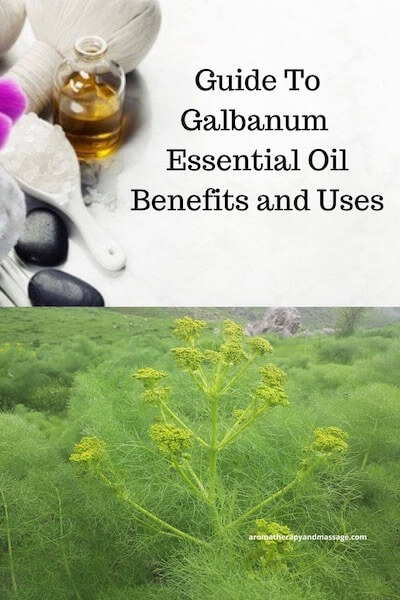- Home
- Essential Oil Profiles
- Galbanum Essential Oil
As an affiliate for Bookshop, Amazon, and other programs, I may earn a small commission for products purchased through links. This doesn't affect the price you pay. Privacy policy and disclosures.
Search this site:
Guide to Galbanum Essential Oil Benefits and Uses
Galbanum essential oil (Ferula galbaniflua or Ferula gummosa) "sheds light on life's purpose and on the inner self...It communicates with the deeper layers of self," writes aromatherapist Valerie Ann Worwood in Aromatherapy For the Soul. She also states the emotional benefits of galbanum are to encourage calm, stability, direction, concentration, fortitude, and focus.

Basic Galbanum Facts
Plant family: Apiaceae/Umbelliferae
Production: Steam distilled from the gum resin that exudes from this large perennial herb. The oil is also available as a CO2 extract.
Aroma: Fresh, sharp, green, earthy, woody.
Perfume/Aromatic note: Top
Is galbanum safe to use during pregnancy? Consult a professional.
Is galbanum essential oil safe for children? Consult a professional.
Cautions: An oxidized oil may cause skin sensitization.
Main components:
- beta-pinene 45.1–58.8%
- gamma-3-carene 2.0–12.1%
- a-pinene 5.7–12.0%
- (+)-limonene 2.7–4.0%
Source: Essential Oil Safety, 2nd Edition
Galbanum Aromatherapy Benefits
Aromatherapy: A Complete Guide to the Healing Art: Galbanum essential oil has been used to soothe inflamed or abscessed wounds, tone mature or irritated skin, and ease emotional tension and muscle aches and pains.
The Complete Book of Essential Oils and Aromatherapy: Galbanum may help relieve skin inflammation, acne, pimples, cuts and wounds, scars, coughs, respiratory difficulties, muscle aches and pains, rheumatoid arthritis, indigestion, and stress/nervous-related conditions.
375 Essential Oils and Hydrosols: Galbanum helps resolve old emotional or spiritual problems. Use the oil to help relieve all types of menstrual problems and heal old skin lesions.
The Encyclopedia of Essential Oils (updated edition): Galbanum tones the skin is useful for mature skin and wrinkles. The oil helps abscesses, acne, boils, cuts, and scar tissue heal. This essential oil may help relieve muscle aches and pains, rheumatism, excess mucous, chronic cough, stomach cramps, indigestion, gas, nervous tension, and stress-related complaints.
The Complete Aromatherapy and Essential Oils Handbook for Everyday Wellness: Galbanum is useful for dealing with skin problems such as abscesses, acne, boils, and wounds. The essential oil is also a tonic for the respiratory system and loosens and removes excessive mucous. In a massage oil, galbanum may relieve muscle aches and pains or, when massaged onto the abdomen, help relieve indigestion, flatulence, and stomach cramps.
Essential Oils: A Comprehensive Handbook for Aromatic Therapy: Suggested essential oils to blend with galbanum (pp. 634–635):
- For skin inflammation and wound healing: lavender, geranium, jasmine, patchouli, sandalwood, cypress, or Virginian cedarwood.
- To relieve muscle aches and pains: lavender, black pepper, clary sage, juniper berry, pink pepper, roman chamomile, or Virginian cedarwood.
- To relieve tension, stress, fatigue, or lethargy: lavender, geranium, or rosewood.
- For respiratory inflammation or congestion: atlas cedarwood, scotch pine, hemlock spruce, rosemary, lemon, or yuzu.
The Complete Guide to Aromatherapy, Third Edition, Vol. 1, suggests blending the following essential oils with galbanum:
- To relieve stress, anxiety, depression, or nervous tension: bergamot, geranium, frankincense, lavender, sweet orange, neroli, pine, or rosemary.
- To relieve mucus: atlas cedarwood, 1,8 cineole-rich eucalyptus, ginger, frankincense, pine, or rosemary.
- To promote wound healing: frankincense, German chamomile, helichrysum, lavender, myrrh, or patchouli.
Aromatica: A Clinical Guide to Essential Oil Therapeutics, Volume 2: Galbanum is a warming stimulant that addresses hyposthenic/weak, atonic/cold, and congestive/damp conditions.
- The rasa (taste) of galbanum is bitter, astringent, pungent; the vipaka (aftertaste) is pungent; and the virya (energy) is cooling and drying.
- The oil vata and pitta and kapha.
- Tissues most affected by the oil are respiratory, endocrine, skin, lymph, and joints.
- Indications for this essential oil include PMS, menopause, lymph congestion, arthritis, infections, colds, flu, paranoia, and anger.
Aromatherapy and Subtle Energy Techniques: Galbanum promotes a sense of stability at the first chakra, fortitude and personal direction at the third chakra, the ability to concentrate at the sixth chakra, and trust and faith in spirit at the seventh chakra.
Sacred Oils: Galbanum can form a bridge between the living and the dead, assists in ritual soul work, and has an affinity with the crown (7th) chakra. The book recommends only experienced practitioners use this powerful oil for spiritual work.
Mixing Essential Oils for Magic: Use galbanum to purify and create sacred space for ritual and meditation. The oil supports spirituality, psychic work, and divination.
Galbanum Essential Oil Uses and Blends
Diffuse galbanum for meditation and to calm the emotions.
Blend galbanum in a cream or lotion to help relieve inflamed or infected skin conditions and ease pain in lower legs, feet, hands, and wrists.
Massage Oil
- 10 drops galbanum essential oil
- 5 drops helichrysum essential oil
- 5 drops copaiba essential oil
- Jojoba oil
Add essential oils to a two-ounce squeeze bottle. Fill the bottle with jojoba oil. Cap and shake to mix well. Apply enough of this blend to cover the inflamed area and gently massage into the skin. (1.7% dilution)
Bath Salts
- 1 drop galbanum essential oil
- 3 drops frankincense essential oil
- 1 tablespoon jojoba oil
- 1/2 cup Epsom salt
Stir together all ingredients. Add to running bath water for a relaxing soak.
Mature Skin Oil
Add 1 drop galbanum to 1 teaspoon rosehip oil. Rub oil onto face, neck, and back of hands.
Adapted from Eden's Garden
General Respiratory Blend
Use this blend in a diffuser, inhaler, or steam inhalation or to make a massage oil for the chest and upper back.
- 1 drop galbanum essential
- 2 drops eucalyptus radiata essential oil
- 3 drops niaouli essential oil
- 3 drops tea tree essential oil
Source: Ron Guba. "True Niaouli." Essential News, Vol. 3, December 2000.
Buy essential oils: Aromatics International or Rocky Mountain Essential Oils.
Photo Credit: Pirehelokan - Own work, CC BY-SA 4.0, via Wikimedia Commons



